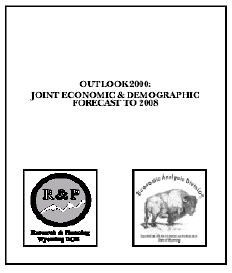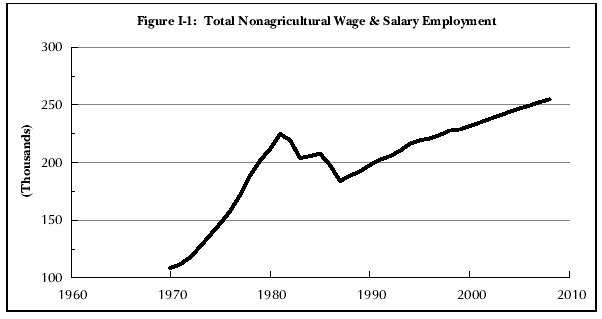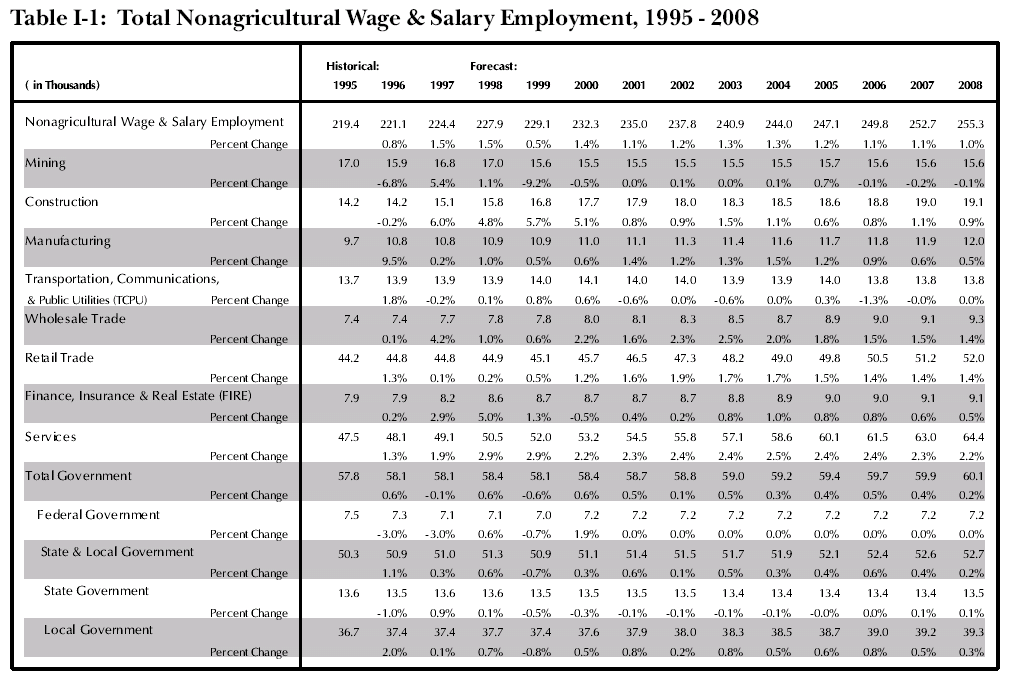|
Introduction:
Wyoming's ability to attract, train, and retain labor
occurs in a competitive regional and national market. To understand how
Wyoming employers compete for skilled labor, we first need to identify
Wyoming's workforce. Chapter 1 briefly
examines employment change by industry, identifying where Wyoming
workers currently work, and describes each major industry's workforce
in terms of gender, age, and earnings. Chapter
2 identifies how employers and workers interact with each other.
The analysis examines how industries utilize their human resources
and the levels of attachment categories of workers have for the
industries in which they work. In examining the relationship between
utilization and labor attachment, Chapter 2 also examines demographic
differences among workers and two types of employee exits from the labor
market--retirement and employee turnover.
Chapter 3 describes changes in the structure of occupational
demand in Wyoming, how these changes relate to worker exits that
occur in the labor market, and how the occupational changes expected
to occur in Wyoming compare to regional and national trends.
Chapter 4 provides a limited view of some
of the job skills associated with the fastest growing occupations in
Wyoming. Chapter 5 provides a wage
analysis of the occupational projections in Chapter 3. This chapter
also examines the correlation between experience/ educational
levels and wage differences between Wyoming, the nation, and the
states to which the Wyoming population is most likely to migrate
(destination states). Finally, in Chapter 6,
our analysis concludes with an application of national industrial
staffing patterns and employment data to compare the competitive
opportunities for private-sector and public-sector employment in
Wyoming, the nation, and five destination states.
In Outlook 2000: Joint
Economic & Demographic Forecast to 2008, the principal
unit of analysis is jobs by industry. By industry, we mean
firms grouped in terms of goods or services produced. In contrast, the
focus of our measures in this publication frequently changes. Within
each chapter, we share data and investigate issues related to change in
the occupational level by shifting among several units of analysis:
industries, firms, jobs, individuals, occupations, and the interaction
between them. This broader approach enables us, for example, to describe
the behavior of industry trends in terms of the number of jobs (the
employer's perspective) and the number of individuals affected (the
employee's perspective).
Because an understanding of these units of analysis
is important to all aspects of this report, they deserve to be reviewed
here. A 'unit of analysis' is the basic operational definition used in
the collection and organization of information.
Industries refer to the activities in which
establishments (firms) are primarily engaged and by which they can be
grouped and categorized. The Standard Industrial Classification (SIC)
coding system1 is used to
assign firms within one of 10 major industries, divided between two
industrial sectors, Goods Producing and Services Producing. The Goods
Producing sector includes four major industries: Agriculture, Mining,
Construction, and Manufacturing. The Services Producing sector includes
the six remaining major industries: Transportation, Communications, &
Public Utilities (TCPU); Wholesale Trade; Retail Trade; Finance, Insurance,
& Real Estate (FIRE); Services; and Government. Each of the 10 major
industries can be divided further into subcategories. The SIC assigns
each industry up to a four-digit code. For example:
SIC 1.
Mining
SIC 10.
Metal Mining
SIC 101.
Iron Ores
SIC 102.
Copper Ores
SIC 109.
Miscellaneous Metal Ores
SIC 1094.
Uranium-Radium-Vanadium Ores
SIC 1099.
Miscellaneous Metal Ores,
Not Elsewhere Classified
SIC 12.
Coal Mining
Firms refer to the establishments, publicly
and privately owned, that employ workers. The firm may employ workers at a
single location (e.g., a locally owned and operated cafe) or among several
locations (i.e., chain department stores or state agencies often employ
people in locations statewide).
Jobs refer to the number of opportunities for
work available, as reported by firms. Jobs can be either 'occupied' or
'vacant,' and they can be characterized further in terms of occupation and
associated skills. A count of jobs is not a count of people, because people
can hold more than one job with different employers and in different
industries. The ES-202 Employer Database maintained by the Wyoming
Department of Employment is a compilation of employer reported data
collected from the Unemployment Insurance (UI) program and supplemented by
statistical surveys. The data include employer characteristics such as
employer unit, the number of jobs (but not the number of occupants of
those jobs), and total wages. The data are reported quarterly by each firm
required to pay Unemployment Insurance taxes. A summary of the data is
published annually.2
Individuals refer to the number of people
participating in the labor market, without regard to the number of
sequential or concurrent jobs they hold during a given time period.
The Wage Records Database (a companion of the ES-202 employer database)
identifies by Social Security Number (SSN) each individual employed by
a firm and that individual's quarterly wages. When SSNs are matched to
demographic data (e.g., age, gender) contained in other administrative
databases (e.g., Driver's License, Employment Services) and firm data
contained in the ES-202, we can characterize the distribution of Wyoming
employees among industries.
To be technically correct and to avoid confusion in our
discussion of labor supply, occupations will not be treated
as distinct units of analysis. Rather, the term will be used in this
publication to describe two other units of analysis mentioned above: the
characteristics of a job (e.g., the position of computer programmer)
and the educational and skill level attained by an individual
(e.g., the computer programmer herself). The term occupation is defined by
the context of its use.
Transactions as units of analysis can be
divided into two categories: market and non-market activities over time.
a) Market transactions include the exchange
of labor for compensation, hiring and exits from and to employment, and
the duration and type of worker incumbency.
b) In addition to employer-worker transactions,
there are worker and employer transactions with market support institutions
such as Unemployment Insurance, training entities, and workforce development
agencies (e.g., agencies which, when taken in their sum, are more popularly
known as the Workforce Development System).
Because shifting among units of analysis sometimes creates
confusion for those unfamiliar with the vocabulary of labor economics, we
have incorporated page tabs in this publication to help readers identify
the location of data and discussions related to the specific units of
analysis. The report also includes a glossary.
1 Executive Office of the President, Office of
Management and Budget,
Standard
Industrial Classification Manual,
1987.
2 Wyoming Department of Employment, Research
& Planning,
Where Are
the Jobs? What Do They
Pay?: 1998 Annual Covered Employment and Wages,
December 1999.
|


